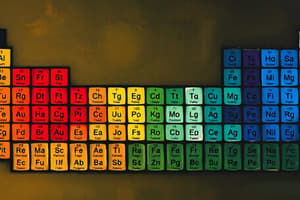Podcast
Questions and Answers
What is the primary basis for arranging elements in the modern periodic table?
What is the primary basis for arranging elements in the modern periodic table?
- Atomic mass
- Atomic number (correct)
- Neutron number
- Mass number
What characteristic do elements in the same group share?
What characteristic do elements in the same group share?
- Same number of valence electrons (correct)
- Same number of protons
- Same atomic number
- Same atomic radius
Which element is located in Group 17 and Period 3 of the periodic table?
Which element is located in Group 17 and Period 3 of the periodic table?
- Fluorine
- Bromine
- Iodine
- Chlorine (correct)
What is the position of the element with atomic number 12 in the periodic table?
What is the position of the element with atomic number 12 in the periodic table?
What are the elements in Group 18 commonly known as?
What are the elements in Group 18 commonly known as?
How does the metallic character change as you move from left to right across a period?
How does the metallic character change as you move from left to right across a period?
Which element has the largest atomic radius?
Which element has the largest atomic radius?
Which alkali metal is the most reactive?
Which alkali metal is the most reactive?
When elements are arranged by increasing atomic number, what occurs at regular intervals?
When elements are arranged by increasing atomic number, what occurs at regular intervals?
What does the periodic law state regarding the properties of elements?
What does the periodic law state regarding the properties of elements?
Flashcards are hidden until you start studying
Study Notes
Modern Periodic Table Organization
- Elements are organized by atomic number, not atomic mass or mass number.
- Elements in the same group share similar characteristics primarily due to having the same number of valence electrons.
Specific Groups and Periods
- Group 17 and Period 3: Chlorine is the element that fits this description.
- Element with atomic number 12 is in Group 2, Period 3, indicating it is Magnesium.
Group Characteristics
- Group 18 elements are known as noble gases.
- As you move left to right across a period, metallic character decreases due to increasing electronegativity and ionization energy.
Atomic Radius and Reactivity
- The element with the largest atomic radius among Sodium (Na), Magnesium (Mg), Aluminium (Al), and Silicon (Si) is Sodium (Na).
- Among alkali metals, Rubidium (Rb) is the most reactive.
Periodic Law and Trends
- Elements exhibit similar chemical properties at regular intervals according to their atomic number.
- The periodic law states that the properties of elements are a periodic function of their atomic number.
Electronegativity and Ionization Energy
- The most electronegative element in the periodic table is Fluorine.
- Ionization energy typically increases across a period and decreases down a group.
Modern Periodic Table Misconceptions
- Statements regarding the periodic table:
- Elements are arranged by increasing atomic number.
- Non-metals are found on the right-hand side, while metals occupy the left.
- True positioning confirms that noble gases are indeed in Group 18, contrary to misconceptions.
Ionic and Chemical Properties
- In the context of ionization energy:
- Sodium has the lowest ionization energy compared to Aluminium, Chlorine, and Phosphorus.
Alkali Metals Group
- Alkali metals are exclusively located in Group 1, which includes elements like Lithium, Sodium, and Potassium.
Studying That Suits You
Use AI to generate personalized quizzes and flashcards to suit your learning preferences.




